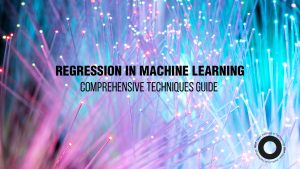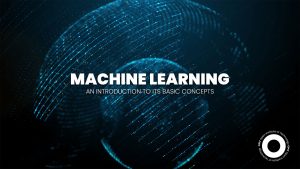
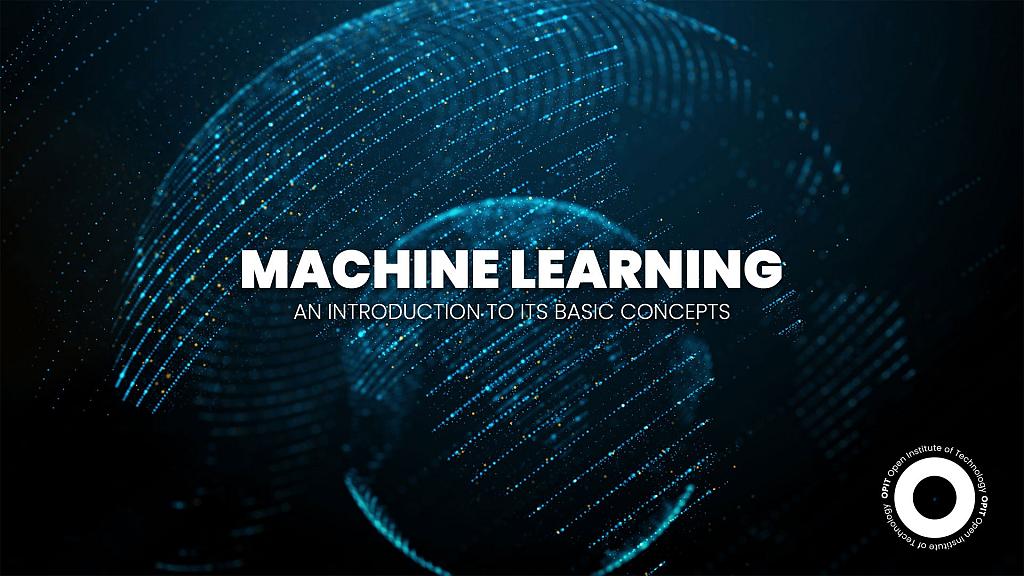
Have you ever played chess or checkers against a computer? If you have, news flash – you’ve watched artificial intelligence at work. But what if the computer could get better at the game on its own just by playing more and analyzing its mistakes? That’s the power of machine learning, a type of AI that lets computers learn and improve from experience.
In fact, machine learning is becoming increasingly important in our daily lives. According to a report by Statista, revenues from the global market for AI software are expected to reach 126 billion by 2025, up from just 10.1 billion in 2018. From personalized recommendations on Netflix to self-driving cars, machine learning is powering some of the most innovative and exciting technologies of our time.
But how does it all work? In this article, we’ll dive into the concepts of machine learning and explore how it’s changing the way we interact with technology.
What is Machine Learning?
Machine learning is a subset of artificial intelligence (AI) that focuses on building algorithms that can learn from data and then make predictions or decisions and recognize patterns. Essentially, it’s all about creating computer programs that can adapt and improve on their own without being explicitly programmed for every possible scenario.
It’s like teaching a computer to see the world through a different lens. From the data, the machine identifies patterns and relationships within it. Based on these patterns, the algorithm can make predictions or decisions about new data it hasn’t seen before.
Because of these qualities, machine learning has plenty of practical applications. We can train computers to make decisions, recognize speech, and even generate art. We can use it in fraud detection in financial transactions or to improve healthcare outcomes through personalized medicine.
Machine learning also plays a large role in fields like computer vision, natural language processing, and robotics, as they require the ability to recognize patterns and make predictions to complete various tasks.
Concepts of Machine Learning
Machine learning might seem magical, but the concepts of machine learning are complex, with many layers of algorithms and techniques working together to get to an end goal.
From supervised and unsupervised learning to deep neural networks and reinforcement learning, there are many base concepts to understand before diving into the world of machine learning. Get ready to explore some machine learning basics!
Supervised Learning
Supervised learning involves training the algorithm to recognize patterns or make predictions using labeled data.
- Classification: Classification is quite straightforward, evident by its name. Its goal is to predict which category or class new data belongs to based on existing data.
- Logistic Regression: Logistic regression aims to predict a binary outcome (i.e., yes or no) based on one or more input variables.
- Support Vector Machines: Support Vector Machines (SVMs) find the best way to separate data points into different categories or classes based on their features or attributes.
- Decision Trees: Decision trees make decisions by dividing data into smaller and smaller subsets from a number of binary decisions. You can think of it like a game of 20 questions where you’re narrowing things down.
- Naive Bayes: Naive Bayes uses Bayes’ theorem to predict how likely it is to end up with a certain result when different input variables are present or absent.
Regression
Regression is a type of machine learning that helps us predict numerical values, like prices or temperatures, based on other data that we have. It looks for patterns in the data to create a mathematical model that can estimate the value we are looking for.
- Linear Regression: Linear regression helps us predict numerical values by fitting a straight line to the data.
- Polynomial Regression: Polynomial regression is similar to linear regression, but instead of fitting a straight line to the data, it fits a curved line (a polynomial) to capture more complex relationships between the variables. Linear regression might be used to predict someone’s salary based on their years of experience, while polynomial regression could be used to predict how fast a car will go based on its engine size.
- Support Vector Regression: Support vector regression finds the best fitting line to the data while minimizing errors and avoiding overfitting (becoming too attuned to the existing data).
- Decision Tree Regression: Decision tree regression uses a tree-like template to make predictions out of a series of decision rules, where each branch represents a decision, and each leaf node represents a prediction.
Unsupervised Learning
Unsupervised learning is where the computer algorithm is given a bunch of data with no labels and has to find patterns or groupings on its own, allowing for discovering hidden insights and relationships.
- Clustering: Clustering groups similar data points together based on their features.
- K-Means: K-Means is a popular clustering algorithm that separates the data into a predetermined number of clusters by finding the average of each group.
- Hierarchical Clustering: Hierarchical clustering is another way of grouping that creates a hierarchy of clusters by either merging smaller clusters into larger ones (agglomerative) or dividing larger clusters into smaller ones (divisive).
- Expectation Maximization: Expectation maximization is quite self-explanatory. It’s a way to find patterns in data that aren’t clearly grouped together by guessing what might be there and refining the guesses over time.
- Association Rule Learning: Association Rule Learning looks to find interesting connections between things in large sets of data, like discovering that people who buy plant pots often also buy juice.
- Apriori: Apriori is an algorithm for association rule learning that finds frequent itemsets (groups of items that appear together often) and makes rules that describe the relationships between them.
- Eclat: Eclat is similar to apriori, but it works by first finding which things appear together most often and then finding frequent itemsets out of those. It’s a method that works better for larger datasets.
Reinforcement Learning
Reinforcement learning is like teaching a computer to play a game by letting it try different actions and rewarding it when it does something good so it learns how to maximize its score over time.
- Q-Learning: Q-Learning helps computers learn how to take actions in an environment by assigning values to each possible action and using those values to make decisions.
- SARSA: SARSA is similar to Q-Learning but takes into account the current state of the environment, making it more useful in situations where actions have immediate consequences.
- DDPG (Deep Deterministic Policy Gradient): DDPG is a more advanced type of reinforcement learning that uses neural networks to learn policies for continuous control tasks, like robotic movement, by mapping what it sees to its next action.
Deep Learning Algorithms
Deep Learning is a powerful type of machine learning that’s inspired by how the human brain works, using artificial neural networks to learn and make decisions from vast amounts of data.
It’s more complex than other types of machine learning because it involves many layers of connections that can learn to recognize complex patterns and relationships in data.
- Neural Networks: Neural networks mimic the structure and function of the human brain, allowing them to learn from and make predictions about complex data.
- Convolutional Neural Networks: Convolutional neural networks are particularly good at image recognition, using specialized layers to detect features like edges, textures, and shapes.
- Recurrent Neural Networks: Recurrent neural networks are known to be good at processing sequential data, like language or music, by keeping track of previous inputs and using that information to make better predictions.
- Generative Adversarial Networks: Generative adversarial networks can generate new, original data by pitting two networks against each other. One tries to create fake data, and the other tries to spot the fakes until the generator network gets really good at making convincing fakes.
Conclusion
As we’ve learned, machine learning is a powerful tool that can help computers learn from data and make predictions, recognize patterns, and even create new things.
With basic concepts like supervised and unsupervised learning, regression and clustering, and advanced techniques like deep learning and neural networks, the possibilities for what we can achieve with machine learning are endless.
So whether you’re new to the subject or deeper down the iceberg, there’s always something new to learn in the exciting field of machine learning!
Related posts
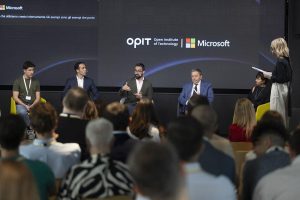
Source:
- Times of Malta, published on September 18th, 2025
4 min read
The gathering brought together academics and technology leaders from prominent European Institutions, such as Instituto de Empresa (IE University), OPIT itself and the Royal College of Arts, to explore how artificial intelligence is reshaping the university experience.
The OPIT AI Copilot has been trained on the institute’s complete academic archive, a collection created over the past three years that includes 131 courses, more than 3,500 hours of recorded lectures, 7,500 study resources, 320 certified assessments, and thousands of exercises and original learning documents.
Unlike generic AI tools, the Copilot is deeply integrated with OPIT’s learning management system, allowing it to track each student’s progress and provide tailored support.
This integration means the assistant can reference relevant sources within the learning environment, adapt to the student’s stage of study, and ensure that unreleased course content remains inaccessible.
A mobile app is also scheduled for release this autumn, that will allow students to download exercise and access other tools.
During examinations, the Copilot automatically switches to what the institute calls an “anti-cheating mode”, restricting itself to general research support rather than providing direct answers.
For OPIT’s international community of 500 students from nearly 100 countries, many of whom balance studies with full-time work, the ability to access personalised assistance at any time of day is a key advantage.
“Eighty-five per cent of students are already using large language models in some way to study,” said OPIT founder and director Riccardo Ocleppo. “We wanted to go further by creating a solution tailored to our own community, reflecting the real experiences of remote learners and working professionals.”
Tool aims to cut correction time by 30%
The Copilot will also reduce administrative burdens for faculty. It can help grade assignments, generate new educational materials, and create rubrics that allow teachers to cut correction time by as much as 30 per cent.
According to OPIT, this will free up staff to dedicate more time to teaching and direct student engagement.
At the Milan event, Rector Francesco Profumo underlined the broader implications of AI in higher education. “We are in the midst of a deep transformation, where AI is no longer just a tool: it is an environment that radically changes how we learn, teach, and create,” he said.
“But it is not a shortcut. It is a cultural, ethical, and pedagogical challenge, and to meet it we must have the courage to rethink traditional models and build bridges between human and artificial intelligence.”
OPIT was joined on stage by representatives from other leading institutions, including Danielle Barrios O’Neill of the Royal College of Art, who spoke about the role of AI in art and creativity, and Francisco Machin of IE University, who discussed applications in business and management education.
OPIT student Asya Mantovani, also employed at a leading technology and consulting firm in Italy, gave a first-hand account of balancing professional life with online study.
The assistant has been in development for the past eight months, involving a team of OPIT professors, researchers, and engineers.
Ocleppo stressed that OPIT intends to make its AI innovations available beyond its own institution. “We want to put technology at the service of higher education,” he said.
“Our goal is to develop solutions not only for our own students, but also to share with global institutions eager to innovate the learning experience in a future that is approaching very quickly.”
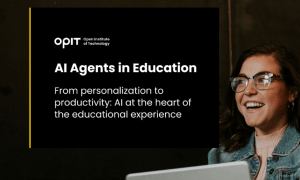
From personalization to productivity: AI at the heart of the educational experience.
Click this link to read and download the e-book.
At its core, teaching is a simple endeavour. The experienced and learned pass on their knowledge and wisdom to new generations. Nothing has changed in that regard. What has changed is how new technologies emerge to facilitate that passing on of knowledge. The printing press, computers, the internet – all have transformed how educators teach and how students learn.
Artificial intelligence (AI) is the next game-changer in the educational space.
Specifically, AI agents have emerged as tools that utilize all of AI’s core strengths, such as data gathering and analysis, pattern identification, and information condensing. Those strengths have been refined, first into simple chatbots capable of providing answers, and now into agents capable of adapting how they learn and adjusting to the environment in which they’re placed. This adaptability, in particular, makes AI agents vital in the educational realm.
The reasons why are simple. AI agents can collect, analyse, and condense massive amounts of educational material across multiple subject areas. More importantly, they can deliver that information to students while observing how the students engage with the material presented. Those observations open the door for tweaks. An AI agent learns alongside their student. Only, the agent’s learning focuses on how it can adapt its delivery to account for a student’s strengths, weaknesses, interests, and existing knowledge.
Think of an AI agent like having a tutor – one who eschews set lesson plans in favour of an adaptive approach designed and tweaked constantly for each specific student.
In this eBook, the Open Institute of Technology (OPIT) will take you on a journey through the world of AI agents as they pertain to education. You will learn what these agents are, how they work, and what they’re capable of achieving in the educational sector. We also explore best practices and key approaches, focusing on how educators can use AI agents to the benefit of their students. Finally, we will discuss other AI tools that both complement and enhance an AI agent’s capabilities, ensuring you deliver the best possible educational experience to your students.
Have questions?
Visit our FAQ page or get in touch with us!
Write us at +39 335 576 0263
Get in touch at hello@opit.com
Talk to one of our Study Advisors
We are international
We can speak in:

